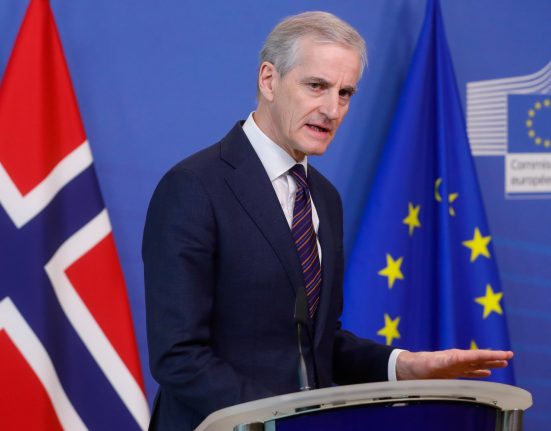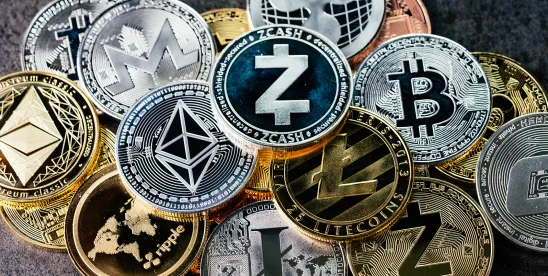Hedge fund manager James Koutoulas remembers when U.S. President Donald J. Trump first awakened to crypto — and it had nothing to do with making a mint.
“Trump got into cryptocurrency back in 2022,” he tells Institutional Investor. “But he really had no idea what it was at first.”
Koutoulas, who runs Miami-based Typhon Capital Management, witnessed it. While attending a $10,000-a-head Christmas fundraiser thrown by Trump in Naples, Florida, he says Trump overheard him talking with some other guests about a recently launched meme coin called “Let’s Go Brandon,” referring to the popular gibe against then-President Joe Biden.
Still stinging from his presidential loss in 2020, Trump perked up at the idea of a satirical cryptocurrency poking fun at his successor. When he learned that a broad cross-section of crypto investors were also Trump supporters, he became even more interested. “Oooh, I like that,” Koutoulas recalls him saying.
By March 2022, Trump had acquired some of the anti-Biden meme coin — says Koutoulas, who gifted it to the president — not for the potential return so much as for the pro-Trump community backing it. Even then, Trump remained unconvinced of crypto’s value proposition, having proclaimed in 2021 that Bitcoin seemed like “a scam against the dollar.” (The White House did not respond to a request for comment.)
It was innocent enough: a departed president, a bit of meme-coin dabbling. But months before Trump returned to the Oval Office on a groundswell of financial support from crypto enthusiasts — including Elon Musk — he’d already made up his mind: “Crypto is one of those things we have to do,” he said during a live broadcast on Musk’s X. “Whether we like it or not, I have to do it.”
Trump’s determined efforts to make good on that promise have ushered in one of the most dramatic policy shifts seen since the dawn of crypto. They have also enriched him, to the tune of an estimated $3.3 billion of his reported $5.5 billion fortune. That means crypto, not real estate, likely makes up the lion’s share of Trump’s riches.
In stark contrast with the Biden administration (and the previous Trump administration), the president and his lieutenants have scrapped the byzantine legal and regulatory rules that previously kept institutional investors at bay and left crypto hamstrung, unlocking billions of dollars of new investment and more than a decade of pent-up demand.
It’s launched a “renaissance of sorts,” says Giovanni Vicioso, global head of cryptocurrency products at the CME Group. “We are certainly in a new era for cryptocurrencies,” he tells Institutional Investor. “It appears the dark ages may be over.”
The difference in the past year alone has been palpable. The CME’s crypto futures and options complex averaged $10.5 billion of trades a day in the first half of 2025, compared with $5.6 billion for the same period a year ago.
One signpost of rising institutional interest has come in the form of fatter block trades, typically driven by the more dominant institutional players. “You can look at the blocks, and we are now seeing 10 percent or so of volume in the form of a block,” Vicioso says. “They tend to be pretty chunky, big trades.” By the end of July, block trades were topping 15 percent of total volume on some days.
Lest there be doubt, the Trump effect — and crypto’s emergent glide path — was immediately evident as soon as he took office. The CME’s top notional trading day for its crypto complex was January 21, the day after Trump’s inauguration, with its crypto futures and options complex clocking $30.3 billion of trades.
In fact, the CME’s top five notional trading days for crypto have all been in 2025, propelled by digital assets going mainstream and growing institutional acceptance. “We are beginning to see some of the larger money managers coming in and more interactions from the banks as well,” says Vicioso.
As of mid-July, the total market capitalization of all cryptocurrencies leapt to more than $4 trillion for the first time, with Bitcoin accounting for more than 50 percent. Meanwhile, U.S. spot Bitcoin exchange-traded funds swelled to more $100 billion of assets under management this year, holding more Bitcoin than any other market participants globally.
What is interesting about this inflection point, says Chris Kuiper, head of research at Fidelity Digital Assets, is that the data shows institutional investors are more interested in Bitcoin and crypto right now than the retail crowd. “This is the first time I have seen institutional interest, or adoption, that is very, very high while retail is very, very low,” he notes.
Fidelity, which offers a popular spot Bitcoin ETF, has an aerial view of how institutional investors are easing into crypto. The ETFs let investors capture cryptocurrencies’ upside without directly exposing them to the vagaries of managing the coins themselves. This effectively offers them the best of both worlds.
Fidelity notes that registered investment advisers are frequently ahead of the curve on crypto, whereas asset owners, such as endowments and pension funds, remain slow to dive in. “Bigger pools of management are more conservative,” Kuiper says. “Pensions, endowments, and foundations are still in the early stages, but they’re asking more questions — and more pointed questions — about the mechanics and how they can get exposure versus saying it’s too volatile. The direction is definitely changing.”
In short, institutional investors are now familiar with crypto and are more prepared to invest. “Even a little bit of Bitcoin can increase your risk-adjusted returns, and that’s the holy grail in investing, as you know,” Kuiper explains. “We’ve had a long enough track record, and they now have a well-informed opinion on it, whereas before it was seen as a waste of their time, and quite frankly I don’t blame them.”
By contrast, interest from retail investors is lower, Kuiper says, as they “go through a lot more extreme or violent cycles,” weathering faddish meme coins, initial coin offerings, and boom-bust cycles that institutional investors avoid.
Institutional investors are starting to overcome entirely reasonable fears that crypto holdings might vaporize, exchanges may blow up, or the associated founders and CEOs will go to prison. (To be sure, all these things could still happen, but the panic is dying down from peak FTX levels.)
It also probably doesn’t hurt that as Trump took office, the U.S. Office of the Comptroller of the Currency and the Federal Deposit Insurance Corp. pulled their anti-crypto guidance (as did the Federal Reserve, at least partially), allowing banks to custody crypto and earning Trump the moniker “the Crypto President.”
Even before Trump returned to Washington, crypto prices were surging. The week he won the election, Bitcoin, the leading cryptocurrency, notched $80,000 for the first time. Last December, Trump was so bold as to take credit when it topped $100,000, another record. And the day after he took office, Bitcoin hit $107,000.
In July, Bitcoin climbed to a new record high of about $123,000, as U.S. lawmakers in the House moved forward with groundbreaking cryptocurrency legislation.
Some believe crypto is gearing up for another massive gallop. David Tawil, president and co-founder of New York–based crypto asset fund ProChain Capital, says he thinks Bitcoin has the potential to enter a supercycle that could send it as high as $250,000 by the end of the year. “I am not a Bitcoin maximalist, and there are potentially better investments right now,” he tells Institutional Investor. “But from a buy-and-hold standpoint, I say thoughtfully, Bitcoin will supplant gold.”
Despite phenomenal returns in crypto — in the high double digits annually for Tawil’s firm — adoption by the most conservative institutional investors has remained sluggish, with pensions and endowments “very scant, very neutral, looking for alpha on a very low-risk basis,” he notes. Others II interviewed for this story reported the same.
According to recent 13F filings, investments by pensions and endowments in crypto remain few and far between, although several have begun investing in Bitcoin — primarily through ETFs, which offer close exposure to the asset without all the red tape. Brown University and University of Austin’s endowments have dipped their toes in, investing several million dollars each, and pension funds such as Michigan Office of Retirement Systems and the State of Wisconsin Investment Board have also made multimillion-dollar investments.
Although Vicioso wouldn’t name specific institutions and banks that have started test-driving crypto on the CME, he did say he’s “seeing more fundamental hedge funds entering the market” amid increased adoption of underlying cryptocurrencies like Bitcoin. He says he believes the shift is “here to stay,” as “you see more corporations holding bitcoins on their balance sheets” and corresponding growth.
The CME offers four of the most popular cryptocurrencies, covering what the exchange calls “the investible market cap” for digital coins: Bitcoin, Ethereum, Solana, and XRP. All were selected “based on client feedback and validation,” an exchange spokesman says.
Very importantly, the contracts are all cash-settled. That means investors can profit off crypto price swings without having to take custody of or manage the digital assets themselves, which can be logistically difficult, subject to security breaches, and risky for non–tech buffs.
Hedge fund manager and crypto investor Roy Niederhoffer, founder of R.G. Niederhoffer Capital Management in New York, says that although he buys and owns cryptocurrencies for himself — and is “as bullish as ever on hard assets” — he invests his clients’ money in “just futures, which is what they are comfortable with.” That’s because there’s then no need to custody the crypto, so clients feel safer while being able to profit off directional bets on crypto prices.
When the CME launched its first Bitcoin futures contract in 2017, it took off immediately, trading $100 million of contracts on the first day. The CME now trades north of $10 billion on average a day, Vicioso says, with much of that powered by institutional investors. This was well evidenced by large-trader data this month.
When the global cryptocurrency market topped $4 trillion last month, the CME’s crypto futures complex set a new record for large open-interest holders in the weeks ending July 14 and July 21, rising to 798 and 883 such holders, respectively. (Large open-interest holders are defined as having 25 or more contracts.) It also marked the biggest single week-over-week surge in crypto futures holdings for the CME’s largest players — “a clear signal of growing institutional demand,” says the exchange spokesperson, who also pointed to greater participation, “deepening liquidity, and broadening interest across our regulated markets.”
Washington’s efforts to establish clear rules of the road for cryptocurrencies will be paramount going forward, Vicioso says, but an increasingly diverse group of crypto converts is already taking the leap. “You have your traditional liquidity providers, the crypto native entities, and specialized crypto hedge funds,” he says. “But now we are starting to attract more macro trading hedge funds” and “strong institutional participation.”
Since Trump’s return to the White House, barely a week has gone by without a barrage of crypto-friendly headlines with far-reaching ramifications for investors. (Just Tuesday came the news Trump will seek to fine banks that discriminate against lending to crypto companies, among other entities.)
From appointing a star lineup of pro-crypto senior government officials beginning late last year to setting up the nation’s first strategic Bitcoin reserve in March to dropping criminal charges this spring against crypto executives — including Binance founder Changpeng Zhao, who had pleaded guilty to money-laundering — Trump and his administration have made it clear they will be pursuing an ambitious agenda to bolster crypto.
Sweeping, bipartisan initiatives by Congress to take a more proactive approach to legislating cryptocurrencies, digital assets, and fintech, as well as announcements from top market watchdogs providing regulatory clarity, have also smoothed the way.
The Genius Act, landmark legislation touted by Trump, passed Congress in July, sending crypto to its most recent highs. The act seeks to lay the groundwork for banks, fintech companies, and major retailers like Amazon and Walmart to issue their own stablecoins, digital currencies used by investors that are typically less volatile than other cryptocurrencies because they’re pegged to the U.S. dollar. (Genius is short for Guiding and Establishing National Innovation for U.S. Stablecoins.)
Stablecoins can be used to send payments to vendors instantly, cutting out intermediaries while offering lower transaction fees and immediate settlements. Thanks to a lack of regulation, they have a murky and controversial history, so this legislation is seen as crucial to establishing federal oversight and legitimizing them.
“The Genius Act will protect consumers, enable responsible innovation, and safeguard the dominance of the U.S. dollar,” says New York Democratic Senator Kirsten Gillibrand, a sponsor of the bill.
U.S. Treasury Secretary Scott Bessent predicted in June that America’s stablecoin market could grow as much as eightfold, to more than $2 trillion, over the next few years.
Earlier this year, Trump’s new Securities and Exchange Commission chairman, Paul Atkins, unveiled a revamped framework for crypto and digital assets, saying they are a “key priority.” He promised that the SEC would modernize regulations to keep pace with innovations in the digital marketplace, breaking from what he called previous administrations’ “head-in-the-sand approach” and “shoot-first-and-ask-questions-later” tactic of “regulation through enforcement.”
The remarks rolled out the welcome mat for crypto, with Atkins stating that the SEC will look to “set fit-for-purpose standards for market participants” and pursue a rational road map for crypto assets while cracking down on bad actors, in hopes of making America the “crypto capital of the planet.”
The salvo, particularly coming from an SEC chairman, propped up crypto in a way no administration had ever dared to before, says John D’Agostino, head of strategy for Coinbase Institutional. “What he did completely transformed the landscape,” he tells Institutional Investor. “America went from being one of the worst places in the world to be involved in crypto to one of the best.”
ProChain’s Tawil says that even as a crypto bull, he’s been stunned by the pace of this year’s reforms. “It’s been astounding, what has happened in such a short amount of time. We have been absolutely dazzled by the change in attitude by the SEC [and] Congress, and the dropping of the legal cases against crypto firms. It is nowhere near the same environment as under the Biden administration.”
About-faces have been instrumental to crypto’s evolution. Under the Biden administration, former SEC chairman Gary Gensler undertook a failing war on crypto. He pushed enforcement actions, lawsuits, and a barrage of accusations of securities law violations against some of the biggest crypto firms and exchanges in the world (including Coinbase, which vehemently denied wrongdoing and whose charges were dropped by Trump’s SEC in February).
Gensler’s predecessor, Jay Clayton — who served in the first Trump administration and is now the U.S. Attorney for the Southern District of New York — initially blasted crypto as a threat to the U.S. dollar, undertaking 57 crypto-related enforcement actions. Once he left the SEC, he pivoted, taking a series of plum roles advising crypto investing firms and explaining in an interview on CNBC that he’d concluded innovations like Bitcoin and blockchain were significant technologies whose “approval is inevitable.”
That doesn’t mean there hasn’t been criticism, as the Trump administration’s clearing away of obstacles to crypto has arguably made the marketplace easier for scammers and fraudsters to infiltrate. Perhaps the most concerning development was the gutting in April of the U.S. Department of Justice’s National Cryptocurrency Enforcement Team, which was tasked with chasing down the same bad actors Atkins promised would be held accountable.
That means that as the crypto market is opening up, key mechanisms to protect investors are being dismantled. With losses from fraud reported to the Federal Trade Commission leaping by 25 percent, to $12.5 billion, last year — with impostor and crypto scams specifically cited — that leniency could come at a cost.
Crypto scams have even affected the Trump administration, with federal prosecutors filing a complaint just before the July 4 holiday weekend, alleging that scammers impersonating Trump and Vice President JD Vance’s inaugural committee had stolen and laundered hundreds of thousands of dollars of crypto donations. They had solicited Trump-Vance supporters using phony email addresses “to trick or coerce” them “into providing them money.”
Notably, Trump also pardoned infamous crypto cybercriminal Ross Ulbricht, known online as “Dread Pirate Roberts,” who ran more than $200 million of sales of illegal drugs and other illicit goods through darknet marketplace Silk Road before he was caught in 2013. The president said he did it in honor of “the Libertarian movement, which supported me so strongly.”
Big picture, it’s not hard to see how the backlash against the U.S. government’s demonization of cryptocurrencies and digital assets helped Trump regain the presidency via lavish donations from crypto kingpins. In March, he held the first-ever cryptocurrency summit at the White House, signaling crypto’s definitive arrival, and in May, he told reporters traveling with him, “I’m a big crypto fan. I’ve been that from the beginning, right from the campaign.”
With Trump’s fortune now inextricably tied to crypto, his evangelizing it while selling meme coins and buying crypto presents a clear conflict of interest. In May, Democratic Senator Jeff Merkley of Oregon and other Senate Democrats introduced the “End Crypto Corruption Act,” which seeks to stop elected officials, senior White House officials, and their families from issuing or endorsing digital assets. The act didn’t get very far before lawmakers recessed for the summer.
Privately, even the most bullish crypto investors have groused about Trump’s self-dealing, but most of them say it will not stop them from investing in crypto. ProChain’s Tawil, a Trump voter, says he isn’t happy about the self-enrichment of members of the Trump administration, but after running a crypto-focused fund for the past several years, he is convinced of the value of the market, with or without politicians in it.
“Last year, we posted a 64 percent net gain, and the year before that, we were up 82 percent,” he tells II. “We’re ahead by double digits again this year. I don’t care what anyone thinks — those are incredible figures. I think that a lot more people are going to invest with these eye-popping returns.”







